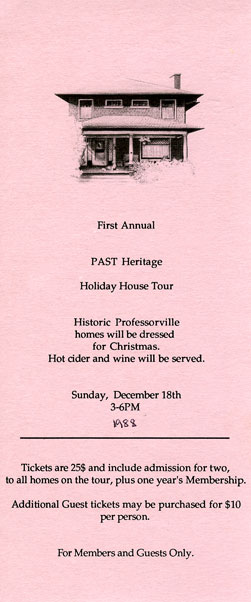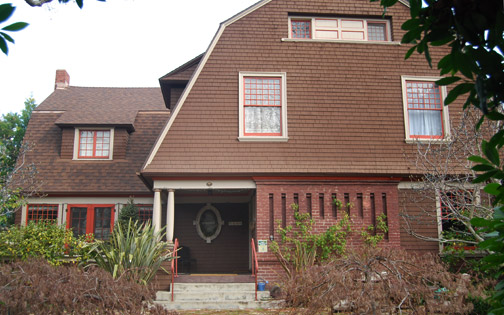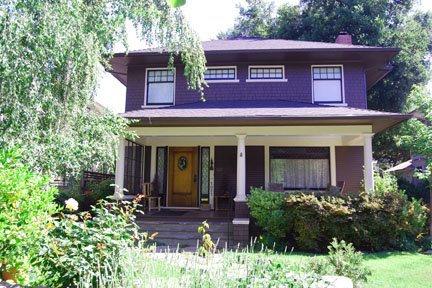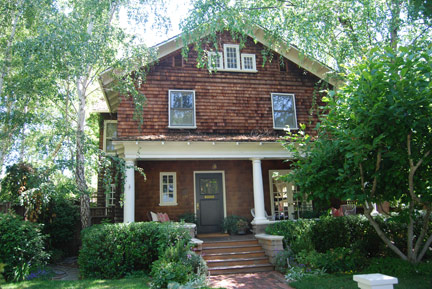 Palo Alto Stanford Heritage
Palo Alto Stanford Heritage
|
 |
The PROFESSORVILLE HISTORIC DISTRICT was placed on the National Register of Historic Places in 1979. Early Stanford University faculty and pioneer Palo Altans built their homes here on land subdivided by Timothy Hopkins for Senator Leland Stanford and opened for development in 1889.
Typical of houses built here were those of the Craftsman style, sheathed in brown shingles with rich wood trim, but eschewing what they felt to be the overly–decorative and superficial Victorian styles. Early examples of the bungalow and the Four–square indigenous styles are also found here.
Professorville today still celebrates the founding of Stanford University and Palo Alto.
|
Built for Professor and Mrs. Frank Angell in the Colonial Revival Style with some Queen Anne detailing, the house features a dominant double gambrel roof. Inside, the first floor is panelled in redwood and contains four fireplaces. Frank Angell was chosen by Stanford President David Starr Jordan in 1892 to head the original Psychology Department. 'Doc' Angell became Stanford's first track coach and Chairman of the Committee on Athletics. In 1933 President Wilbur dedicated Angell Field in his honor. Louise Angell was an active supporter of educational and cultural activities. She financed the establishment of Castilleja Hall at 1129 Bryant Street in 1901. |

|
|
Typical of turn of the century small scale housing, this house survives virtually intact in its original appearance. Note that 1029 Ramona is its twin. The restrained Colonial Revival design features a generous front porch supported by Tuscan columns and an interesting fenestration pattern at the second story. Notice the use of leaded glass panels at the first story. First occupied by Mrs. E. Melcer and daughter, it was subsequently owned by Mr. and Mrs. Franklin Steinmetz for 41 years. He operated the University Pharmacy in downtown Palo Alto. This house was also on the 23rd Holiday House Tour in 2010. |
 |
|
The entrance porch of this simple shingled box with a two story high projecting square bay originally ran the entire width of the house. The deteriorated structure was rehabilitated in 1985 to its original flavor. The rear entry was enlarged, a side entry added, and French doors or windows introduced in compatible style. The interior was opened up and additionally detailed. Notable occupants of the house over the years included Professor and Mrs. Edward Franklin, he an expert in organic chemistry who joined the Stanford faculty in 1898, and Mr. and Mrs. Charles Ellet, owners of the Stanford Bank and Stanford Realty. |

|
As reported in the On the Peninsula column by Kathleen Donnelly in the San Jose Mercury News, Friday morning, December 16, 1988:
Saving, celebrating our historic homes
When Gail Woolley got involved in the historic–preservation movement in 1970, the question was whether old houses would be saved. Now, the question is whether they can be preserved as originally designed, and even celebrated.
The preservation part is still problematic, but the celebration part starts Sunday when PAST Heritage, dedicated to the preservation of historically significant architecture on the Mid–Peninsula, holds a tour of four homes in Palo Alto's Professorville.
The tour is a way of introducing PAST Heritage to the community, says Woolley, a Palo Alto city councilwoman and PAST Heritage organizer. The group, whose name comes from combining Palo Alto and Stanford, was formed in 1987 to plan for the 1988 California Preservation Conference held in Palo Alto. Interest in the committee out–lasted the conference.
This spring, the group plans to hold a workshop on restoring older houses and to establish docent–led walking tours, starting with downtown Palo Alto.
But first, they have to get through Sunday's house tour. The featured houses were built in 1893, 1901, 1905 and 1906, as Stanford professors moved into the blocks just south of downtown Palo Alto. Each of the houses will be decorated for the holidays, and refreshments will be served.
Tickets were $25.
E-mail us at either webmaster@pastheritage.org or president@pastheritage.org.
![]() Palo Alto Stanford Heritage—Dedicated to the preservation of Palo Alto's historic buildings.
Palo Alto Stanford Heritage—Dedicated to the preservation of Palo Alto's historic buildings.
Copyright © 2015 Palo Alto Stanford Heritage. All rights reserved.